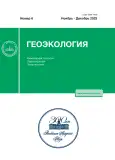MODELING OF PORE WATER PRESSURE IN FREEZING DISPERSED SOILS DURING MOISTURE MIGRATION
- Autores: Bicheng Z.1, Brushkov A.V.1, JiaBo H.2
-
Afiliações:
- Lomonosov Moscow State University
- China University of Geosciences
- Edição: Nº 6 (2023)
- Páginas: 39-46
- Seção: MODELS IN ENGINEERING GEOLOGY AND HYDROGEOLOGY
- URL: https://bakhtiniada.ru/0869-7809/article/view/233676
- DOI: https://doi.org/10.31857/S0869780923060024
- EDN: https://elibrary.ru/CUCUPA
- ID: 233676
Citar
Texto integral
Resumo
Frost heaving of soils is the main cause of engineering accidents in cold regions, but the current experimental as well as numerical studies focus on frost heaving deformation of soils, while there are fewer numerical studies on the main factors causing frost heaving deformation: pore water pressure. In this study, new calculation formulas of pore water pressure for saturated frozen soil are obtained by solving Gibbs free energy equation, and a thermo-hydraulic coupling model under different boundary conditions is constructed to calculate the pore water pressure values and water flow during water migration process. The results showed: (1) the pore water pressure of freezing soil with the ice lens is about ten times that without the ice lens, and the calculated results agree with the previous known experimental results; (2) The temperature of the cold end directly determines the upper limit of the pore water pressure value of freezing soil; (3) Pore water pressure decreases with depth much faster than the rate of temperature decrease.
Palavras-chave
Sobre autores
Zhou Bicheng
Lomonosov Moscow State University
Autor responsável pela correspondência
Email: zhoubicheng@mail.ru
Russia, 119991, Moscow, Leninskie gory 1
A. Brushkov
Lomonosov Moscow State University
Autor responsável pela correspondência
Email: brouchkov@geol.msu.ru
Russia, 119991, Moscow, Leninskie gory 1
Hu JiaBo
China University of Geosciences
Autor responsável pela correspondência
Email: jiabo96@163.com
China, 430074, Wuhan, Hubei, Lumo Av.
Bibliografia
- Akagawa, S., Hiasa, S., Kanie, S. et al. Pore water and effective pressure in the frozen fringe during soil freezing. In: Proc. the 9th Int. Conf. on Permafrost, 2008, pp. 13–18. https://doi.org/10.1016/j.coldregions.2019.102899
- Bai Qing-Bo, Li Xu, Tian Ya-Hu, Fang Jian-Hong. Equations and numerical simulation for coupled water and heat transfer in frozen soil. Chinese Journal of Geotechnical Engineering, 2015, vol. 37 (2), pp. 131–136.
- Beskow, G. Soil freezing and frost heaving with special application to roads and railroads: with special supplement for the English translation of progress from 1935 to 1946. Technological Institute, Northwestern University. 1947. https://doi.org/10.1097/00010694-194804000-00015
- Fowler, A. Secondary frost heaving in freezing soils. SLAM Journal on Applied Mathematics, 1989, vol. 49, pp. 991–1008. https://doi.org/10.1137/0149060
- Geng, L., Tang, S.Y., Cong, X.Z. Ling, J.Lu. Three-dimensional analysis of geosynthetic-encased granular columns for liquefaction mitigation. Geosynthetics International, 2016, vol. 24 (1), pp. 45–59. https://doi.org/10.1680/jgein.16.00014
- Harlan, R.L. Analysis of coupled heat-fluid transport in partially frozen soil. Water Resources Research, 1973, vol. 9 (5), pp. 1314–1323. https://doi.org/10.1029/wr009i005p01314
- Hoekstra, P. Moisture movement in soils under temperature gradients with the cold-side temperature below freezing. Water Resources Research, 1996, vol. 2 (2), pp. 241–250. https://doi.org/10.1029/wr002i002p00241
- Huang, X., Rudolph, D.L. Coupled model for water, vapour, heat, stress and strain fields in variably saturated freezing soils. Advances in Water Resources, 2021, vol. 154, pp. 39–45. https://doi.org/10.1016/j.advwatres.2021.103945
- Konrad, J.M. Unfrozen water as a function of void ratio in a clayey silt. Cold Region Science and Technology, 1990, vol. 18 (1), pp. 49–55. https://doi.org/10.1016/0165-232x(90)90037-w
- Konrad, J.M., Duquennoi, C. A model for water transport and ice lensing in freezing soils. Water Resources Research, 1993, vol. 29 (9), pp. 3109–3124. https://doi.org/10.1029/93wr00773
- Konrad, J.M., Morgenstern, N.R. A mechanistic theory of ice lens formation in fine-grained soils. Canadian Geotechnical Journal, 1980, vol.17, pp. 473–486. https://doi.org/10.1139/t80-056
- Lai, L., Zhang, M. et al. Study on theory model of hydro-thermal-mechanical interaction process in saturated freezing silty soil. Int. Journal of Heat and Mass Transfer, 2014, vol. 78, pp. 805–819. https://doi.org/10.1016/j.ijheatmasstransfer.2014.07.035
- Loch, J.P.G., Kay, B.D. Water Redistribution in Partially Frozen, Saturated Silt Under Several Temperature Gradients and Overburden Loads. Soil Science Society of America Journal, 1978, vol. 42 (30), pp. 400–406. https://doi.org/10.2136/sssaj1978.03615995004200030005x
- Lu Ning, Likos William J. Unsaturated soil mechanics. Beijing: Higher Education Press, 2012, pp. 269–287.
- Miller, R.D. Freezing and heaving of saturated and unsaturated soils. Highway Research Record, 1972, vol. 393, pp. 1–11. https://doi.org/10.1029/2011wr010512
- Miller, R.D. Frost heaving in non-colloidal soils. In: Proc. 3rd Intern. Permafrost Conf., Edmonton, Canada, 1978, pp. 708–713.
- Miller, R.D. Lens initiation in secondary heaving. Highway research record, 1972, vol. 393, pp. 1–11.
- O’Neill, K. The physics of mathematical frost heave models: a review. Cold Regions Science and Technology, 1983, vol. 6 (3), pp. 275–291. https://doi.org/10.1016/0165-232x(83)90048-4
- Taber, S. Frost heaving. The Journal of Geology, 1929, vol. 37 (5), pp. 428–461. https://doi.org/10.1086/623637
- Thomas, H.R., Cleall, P. et al. Modelling of cryogenic processes in permafrost and seasonally frozen soils. Geotechnique, 2009, vol. 29 (3), pp. 173–184. https://doi.org/10.1680/geot.2009.59.3.173
- Zeng Guijun, Zhang Mingyi, Li Zhenping et al. Review of mechanical criterion for formation of ice lens in freezing soil. J. of Glaciology and Geocryology, 2015, vol. 37 (1), pp. 192–201.
- Zhang Lian-Hai, Ma Wei, Shi Ya-Jun et al. The modes and its implications of water accumulation near the freezing front during soil freezing with considering ice segregation. J. of Glaciology and Geocryology, 2022, vol. 44 (6), pp. 1–11.
- Zhou, J.Z., Li, D. Numerical analysis of coupled water, heat and stress in saturated freezing soil. Cold Regions Science & Technology, 2012, vol. 72, pp. 43–49. https://doi.org/10.1016/j.coldregions.2011.11.006
Arquivos suplementares
















